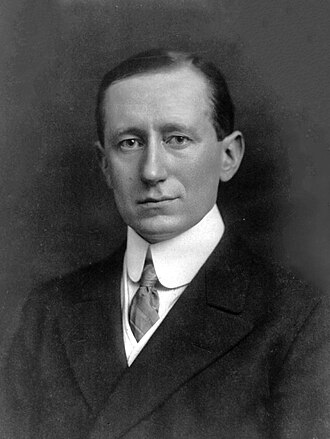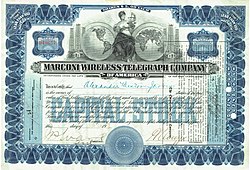Guglielmo Marconi
Guglielmo Marconi (25 April 1874 – 20 July 1937) was an Italian inventor and electrical engineer. He was a pioneer of long-distance radio transmission.[1] which he used to build up a radio telegraph system. Marconi is often named as the inventor of radio. He shared the 1909 Nobel Prize in Physics with Karl Ferdinand Braun.[2][3][4]
Guglielmo Marconi | |
|---|---|
 | |
| Born | 25 April 1874 |
| Died | 20 July 1937 (aged 63) Rome, Italy |
| Alma mater | University of Bologna |
| Known for | Radio |
| Awards | Nobel Prize for Physics (1909) |
| Signature | |
Much of Marconi's work in radio transmission was built on previous experimentation,[5] and work by others. When he was twenty years old, based on the experiments of Hertz, Popov, Lodge, Bose, and Tesla, Marconi began his own experiments.
As an entrepreneur, businessman, and founder of The Wireless Telegraph & Signal Company in Britain in 1897, Marconi became wealthy in the business of radio, mainly for ships at sea.[6][7] In 1924, he was ennobled as Marchese Marconi. Back in Italy, he went on to become a member of the Grand Council of Fascism.
Guglielmo Marconi Media
Marconi's first transmitter incorporating a monopole antenna. It consisted of an elevated copper sheet (top) connected to a Righi spark gap (left) powered by an induction coil (centre) with a telegraph key (right) to switch it on and off to spell out text messages in Morse code.
British Post Office engineers inspect Marconi's radio equipment during a demonstration on Flat Holm Island, 13 May 1897. The transmitter is at the centre, the coherer receiver below it, and the pole supporting the wire antenna is visible at top.
Plaque on the outside of the BT Centre commemorates Marconi's first public transmission of wireless signals.
Marconi watching associates raising the kite (a "Levitor" by Baden Baden-Powell) used to lift the antenna at St. John's, Newfoundland, December 1901
Magnetic detector by Marconi used during the experimental campaign aboard a ship in summer 1902, exhibited at the Museo Nazionale Scienza e Tecnologia Leonardo da Vinci of Milan
References
- ↑ "Guglielmo Marconi – the father of long distance radio communication – an engineer's tribute".
- ↑ "Guglielmo Marconi: The Nobel Prize in Physics 1909"
- ↑ Bondyopadhyay, P. K. (January 1998). "Welcome to IEEE Xplore 2.0: Sir J.C. Bose diode detector received Marconi's first transatlanticwireless signal of December 1901 (the "Italian Navy Coherer"Scandal Revisited)". Proceedings of the IEEE. Ieeexplore.ieee.org. 86 (1): 259–285. doi:10.1109/5.658778. Retrieved 2009-01-29.
- ↑ Roy, Amit (2008-12-08). "Cambridge 'pioneer' honour for Bose". The Telegraph (Calcutta: Telegraphindia.com). http://www.telegraphindia.com/1081208/jsp/nation/story_10221833.jsp. Retrieved 2010-06-10.
- ↑ Williams H.S., & Williams E.H. 1910. Every-day science. New York: Goodhue Company. Page 54.
- ↑ Icons of invention: the makers of the modern world from Gutenberg to Gates. ABC-CLIO. 2009. ISBN 9780313347436. Retrieved 2011-07-08.
- ↑ Ingenious Ireland: a county-by-county exploration of the mysteries and marvels of the ingenious Irish. Simon and Schuster. December 2003. ISBN 9780684020945. Retrieved 2011-07-08.
Other websites
![]() Media related to Guglielmo Marconi at Wikimedia Commons
Media related to Guglielmo Marconi at Wikimedia Commons








